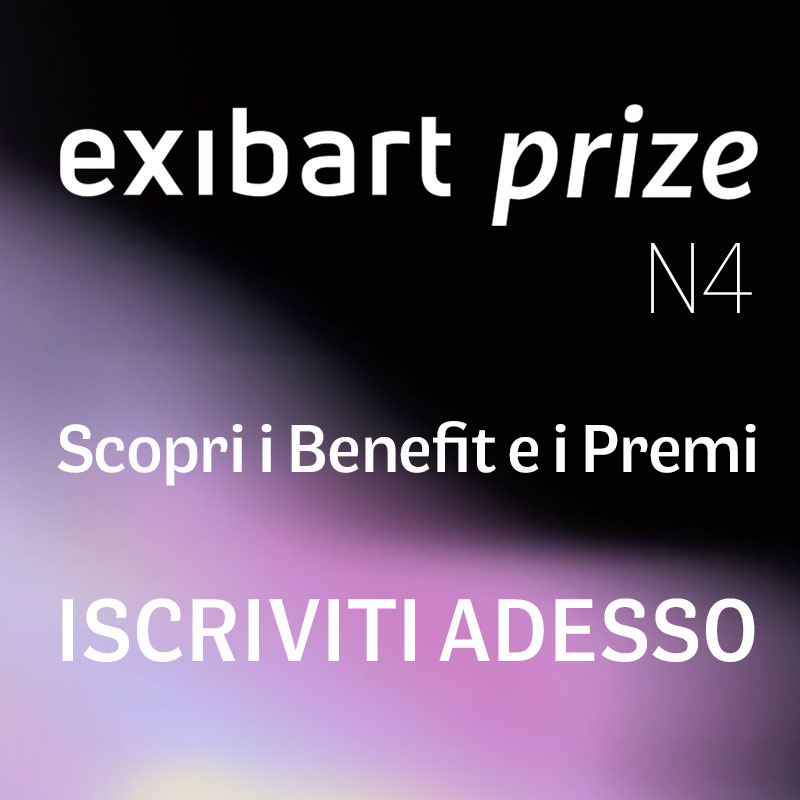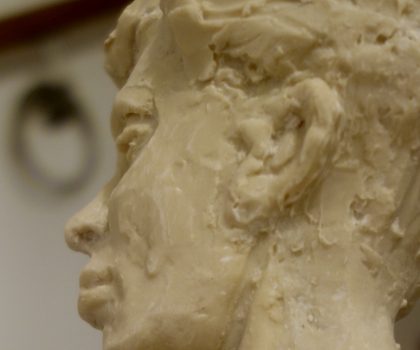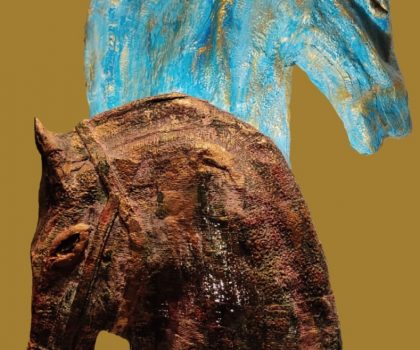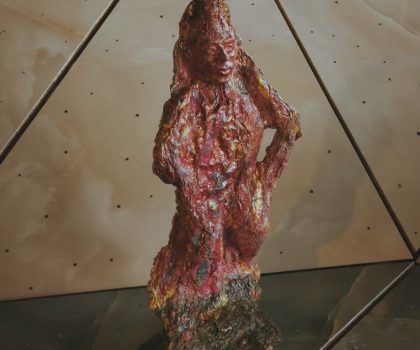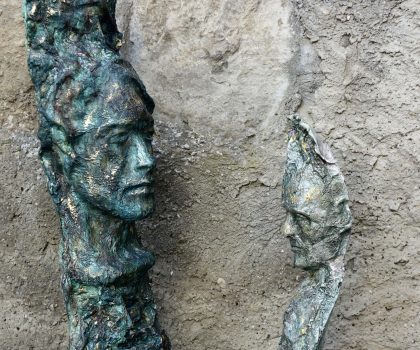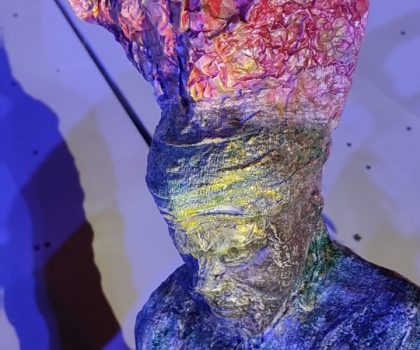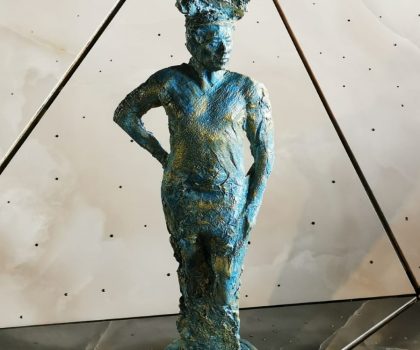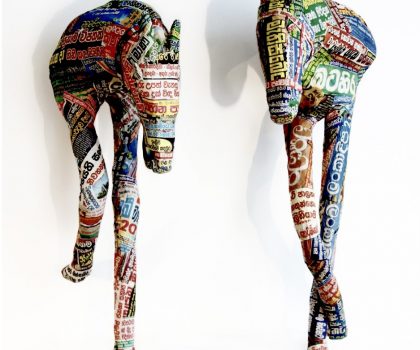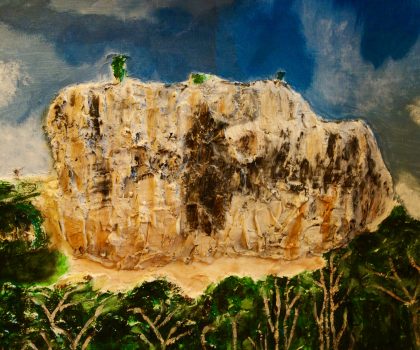Happening06 Dic 2021
Un progetto multidisciplinare per vivere la Magia di Sigiriya
Nato nello Sri Lanka, a Balapitiya, in un villaggio lambito dalle acque del fiume Madu Ganga e dall’Oceano indiano, cullato da energie ancestrali e da suggestive tradizioni, al cospetto di una Natura ancora sovrana, DuminDa, forte del suo percorso formativo e spirituale, inizia un lungo viaggio, ricco di coincidenze significative, cambiamenti di carriera e piacevoli imprevisti, che lo porterà, a partire dal 1998, da Colombo a Seul, da Milano a Lussemburgo, da Parigi a Roma, alla scoperta di nuove culture e d’importanti riferimenti artistici. E’ del 2008 la sua prima galleria di personaggi stilizzati, “Paper Moods”, realizzati con la tecnica del découpage-collage, ritagli di giornale assemblati con una piacevolissima estetica, esaltata dall’esotismo dell’alfabeto cingalese, con il quale ricompone storie ed immagini, in una nuova logica ed armonia di segni. Forte dell’entusiasmo suscitato da queste sue prime sperimentazioni, diventate suo segno distintivo, realizza, poi, altre opere originali, come la”barca della pace” (suo logo), in omaggio ai pescatori dello Sri Lanka ed ai migranti in mare, installazioni di colombe/nuvole e totems colorati. Dal 2012 al 2014, DuminDa inizia un percorso accademico, frequentando stages estivi presso la Kunstakademie di Trevi e Beaux-Arts, a Parigi. Determinante l’incontro con il “Maestro” Philippe Seene’, grande estimatore e geniale interprete dell’Estetica rinascimentale, suo insegnante dall’autunno del 2014 in poi, a Parigi: ritratti e nudi dal vivo, basso-rilievi ed incisioni. Come in un “Tangram”, DuminDa scompone e ricompone frammenti di pensieri, pigmenti di colore, momenti di vita, presenti o passati, plasmando forme del suo immaginario e modelli reali, liberamente reinterpretati. Inconfondibili le sue opere in gesso, murali o autoportanti/totems, con patine sovrapposte, lavorate con la tecnica del “froissé”, pennellate d’oro, per una “texture” organica, a “colata di lava”, con effetti metallo e/o legno, una consistenza che incuriosisce anche i conoscitori d’arte: “Is this bronze?” Sbalzi materici e superfici torturate per visi e corpi, straordinariamente umani, pathos e saudade, nel pieno rispetto del pubblico, invitato da DuminDa ad apprezzare, poco a poco e con semplicità, la sua “slow art”. Affascinato dagli affreschi di Sigiriya (400 d.C.), magico sito archeologico dello Sri Lanka, DuminDa se ne ispira per sperimentare tinture naturali, te’, bacche e vegetali. Eclettico e creativo, poco incline alla comunicazione verbale, poeta del visivo, l’artista crea spontaneamente, senza malizia, fuori da ogni schema e sistema prestabiliti, opere tridimensionali, ispirandosi a sentimenti e sensazioni, vibrazioni, sfumature e ricordi. “Swinging” tra Sogno e Realtà, Oriente ed Occidente, tra il Magico ed il Fiabesco, con stili sempre diversi, DuminDa segue solo il suo istinto, il battito scandito della sua Musica interiore, l’ispirazione del momento, i suoi stati d’animo/MOODS, per condividere un momento di Magia, un bene dello Spirito, il Mantra di una meditazione.
“We laud the beauty of skills slowly acquired, and the deliberate art that reflects such skills.”
Slow Art Manifesto, New York, 2005.
https://www.duminda-art.com( bozza)
With roots in Sri Lanka, and wings that have carried him through Seoul, Milan, Luxembourg, Paris and Rome, DuminDa’s art is an expression of his formative life, his spiritual training, and his appreciation of Beauty in its omnipresent manifestations.
Born in Balapitiya – a village washed by the waters of both the Madu Ganga river and the Indian Ocean –, nurtured by ancestral energies and traditions, and ruled by Mother Nature, DuminDa grew up with very well-defined values, and a strong taste for adventure.
Swinging back and forth between the figurative and the free-style, with devotion and clear intention, DuminDa’s work evokes the delicate balance between dream and reality, magic and nature, east and west. With a découpage-collage technique of his own, DuminDa began assembling aesthetically-matching newspaper clippings with an exotic twist: the letters of the Sinhala alphabet letters and their intriguing symbolism.
In 2008, his first installation of newspaper figurines, Paper Moods, was showcased in the main entrance of the European Commission building in Luxembourg. Eclectic, taciturn, very much a visual poet, DuminDa creates spontaneously, unbound by any predefined scheme or system, producing tridimensional artwork inspired by sensations, vibrations, nuances and memories, states of mind.
By serenely listening to the beat of his inner mystic music and to his deeply-rooted beliefs, DuminDa trained himself to model minimalistic shapes and shadows. Blending plaster, gold and fantasy, DuminDa created what would become his ‘logo’, a boat which is also a peace sign dedicated to people at sea, at large. This was followed by his ‘painted totems’ collection, a format he will revisit in future.
As of 2011, DuminDa attended the Trier Summer Academy and Beaux Arts, in Paris, travelled extensively in Europe and the U.S. Among his numerous favourite masters are Raphaël, Leonardo and Michelangelo; he also has a special affinity with Giacometti, whose work he discovered while visiting the Louisiana Museum (and got inspired by, long before, without even knowing him) and a strong fascination for Egon Schiele and his drawings, which he likes to reproduce on terracotta engravings. In his sculptures, DuminDa enjoys working with resins, newspapers, self-hardening natural eco-clay, plaster, and scotch-tape, with a constant quest for new materials. Using a technique that goes back some 1,600 years – the frescoes of Sigiriya, one of the most awe-inspiring sites of his beloved Sri Lanka -, Duminda has also experimented with patinas based on tea, fruit and vegetables. As of October 2014, DuminDa had the privilege of studying in Paris with Professor Philippe Seené, a great lover of the Renaissance who soon became his mentor. After acquiring the necessary technical skills, DuminDa then started developing his own sculpting style: unpolished, unfinished surfaces, which he felt might best represent the human soul, and a palpable ‘saudade’ in most of his characters’ posture and glance.
As in a ‘Tangram’, in which thoughts, pigments and fragments of his past and present lives are restructured and reassembled, DuminDa depicts an imaginary world intertwined with reality. After practising the academic art of portraits and full bodies, he reverted to his favourite format of plaster totems and rich patina, turning the white, washed-out gips into a sophisticated mysterious material, mocking antique bronze, with a very unusual ‘wrinkled’ effect. An illusion that art-goers and experts fall for. “Is this bronze?” Sheer alchemy… Unconsciously inspired by the costumes of Kandy dancers, DuminDa devised a stylised version of their bonnets, a semblance of a crown or aura above his totems’ heads. DuminDa’s version of “slow art” is a meditative creative process, a simple and profound way of thinking, a passionate devotion.
“We laud the beauty of skills slowly acquired, and the deliberate art that reflects such skills.”
Slow Art Manifesto, New York, 2005
“We laud the beauty of skills slowly acquired, and the deliberate art that reflects such skills.”
Slow Art Manifesto, New York, 2005.
https://www.duminda-art.com( bozza)
With roots in Sri Lanka, and wings that have carried him through Seoul, Milan, Luxembourg, Paris and Rome, DuminDa’s art is an expression of his formative life, his spiritual training, and his appreciation of Beauty in its omnipresent manifestations.
Born in Balapitiya – a village washed by the waters of both the Madu Ganga river and the Indian Ocean –, nurtured by ancestral energies and traditions, and ruled by Mother Nature, DuminDa grew up with very well-defined values, and a strong taste for adventure.
Swinging back and forth between the figurative and the free-style, with devotion and clear intention, DuminDa’s work evokes the delicate balance between dream and reality, magic and nature, east and west. With a découpage-collage technique of his own, DuminDa began assembling aesthetically-matching newspaper clippings with an exotic twist: the letters of the Sinhala alphabet letters and their intriguing symbolism.
In 2008, his first installation of newspaper figurines, Paper Moods, was showcased in the main entrance of the European Commission building in Luxembourg. Eclectic, taciturn, very much a visual poet, DuminDa creates spontaneously, unbound by any predefined scheme or system, producing tridimensional artwork inspired by sensations, vibrations, nuances and memories, states of mind.
By serenely listening to the beat of his inner mystic music and to his deeply-rooted beliefs, DuminDa trained himself to model minimalistic shapes and shadows. Blending plaster, gold and fantasy, DuminDa created what would become his ‘logo’, a boat which is also a peace sign dedicated to people at sea, at large. This was followed by his ‘painted totems’ collection, a format he will revisit in future.
As of 2011, DuminDa attended the Trier Summer Academy and Beaux Arts, in Paris, travelled extensively in Europe and the U.S. Among his numerous favourite masters are Raphaël, Leonardo and Michelangelo; he also has a special affinity with Giacometti, whose work he discovered while visiting the Louisiana Museum (and got inspired by, long before, without even knowing him) and a strong fascination for Egon Schiele and his drawings, which he likes to reproduce on terracotta engravings. In his sculptures, DuminDa enjoys working with resins, newspapers, self-hardening natural eco-clay, plaster, and scotch-tape, with a constant quest for new materials. Using a technique that goes back some 1,600 years – the frescoes of Sigiriya, one of the most awe-inspiring sites of his beloved Sri Lanka -, Duminda has also experimented with patinas based on tea, fruit and vegetables. As of October 2014, DuminDa had the privilege of studying in Paris with Professor Philippe Seené, a great lover of the Renaissance who soon became his mentor. After acquiring the necessary technical skills, DuminDa then started developing his own sculpting style: unpolished, unfinished surfaces, which he felt might best represent the human soul, and a palpable ‘saudade’ in most of his characters’ posture and glance.
As in a ‘Tangram’, in which thoughts, pigments and fragments of his past and present lives are restructured and reassembled, DuminDa depicts an imaginary world intertwined with reality. After practising the academic art of portraits and full bodies, he reverted to his favourite format of plaster totems and rich patina, turning the white, washed-out gips into a sophisticated mysterious material, mocking antique bronze, with a very unusual ‘wrinkled’ effect. An illusion that art-goers and experts fall for. “Is this bronze?” Sheer alchemy… Unconsciously inspired by the costumes of Kandy dancers, DuminDa devised a stylised version of their bonnets, a semblance of a crown or aura above his totems’ heads. DuminDa’s version of “slow art” is a meditative creative process, a simple and profound way of thinking, a passionate devotion.
“We laud the beauty of skills slowly acquired, and the deliberate art that reflects such skills.”
Slow Art Manifesto, New York, 2005

